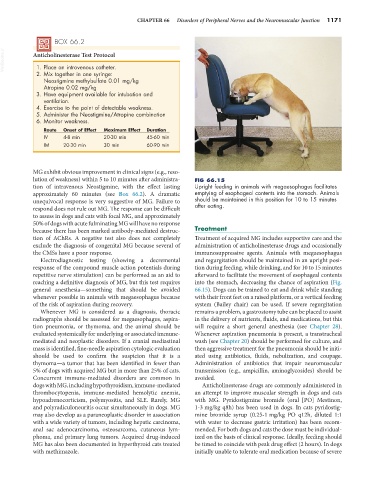Page 1199 - Small Animal Internal Medicine, 6th Edition
P. 1199
CHAPTER 66 Disorders of Peripheral Nerves and the Neuromuscular Junction 1171
BOX 66.2
VetBooks.ir Anticholinesterase Test Protocol
1. Place an intravenous catheter.
2. Mix together in one syringe:
Neostigmine methylsulfate 0.01 mg/kg
Atropine 0.02 mg/kg
3. Have equipment available for intubation and
ventilation.
4. Exercise to the point of detectable weakness.
5. Administer the Neostigmine/Atropine combination
6. Monitor weakness.
Route Onset of Effect Maximum Effect Duration
IV 4-8 min 20-30 min 45-60 min
IM 20-30 min 30 min 60-90 min
MG exhibit obvious improvement in clinical signs (e.g., reso-
lution of weakness) within 5 to 10 minutes after administra- FIG 66.15
tion of intravenous Neostigmine, with the effect lasting Upright feeding in animals with megaesophagus facilitates
approximately 60 minutes (see Box 66.2). A dramatic emptying of esophageal contents into the stomach. Animals
unequivocal response is very suggestive of MG. Failure to should be maintained in this position for 10 to 15 minutes
respond does not rule out MG. The response can be difficult after eating.
to assess in dogs and cats with focal MG, and approximately
50% of dogs with acute fulminating MG will have no response
because there has been marked antibody-mediated destruc- Treatment
tion of AChRs. A negative test also does not completely Treatment of acquired MG includes supportive care and the
exclude the diagnosis of congenital MG because several of administration of anticholinesterase drugs and occasionally
the CMSs have a poor response. immunosuppressive agents. Animals with megaesophagus
Electrodiagnostic testing (showing a decremental and regurgitation should be maintained in an upright posi-
response of the compound muscle action potentials during tion during feeding, while drinking, and for 10 to 15 minutes
repetitive nerve stimulation) can be performed as an aid to afterward to facilitate the movement of esophageal contents
reaching a definitive diagnosis of MG, but this test requires into the stomach, decreasing the chance of aspiration (Fig.
general anesthesia—something that should be avoided 66.15). Dogs can be trained to eat and drink while standing
whenever possible in animals with megaesophagus because with their front feet on a raised platform, or a vertical feeding
of the risk of aspiration during recovery. system (Bailey chair) can be used. If severe regurgitation
Whenever MG is considered as a diagnosis, thoracic remains a problem, a gastrostomy tube can be placed to assist
radiographs should be assessed for megaesophagus, aspira- in the delivery of nutrients, fluids, and medications, but this
tion pneumonia, or thymoma, and the animal should be will require a short general anesthesia (see Chapter 28).
evaluated systemically for underlying or associated immune- Whenever aspiration pneumonia is present, a transtracheal
mediated and neoplastic disorders. If a cranial mediastinal wash (see Chapter 20) should be performed for culture, and
mass is identified, fine-needle aspiration cytologic evaluation then aggressive treatment for the pneumonia should be initi-
should be used to confirm the suspicion that it is a ated using antibiotics, fluids, nebulization, and coupage.
thymoma—a tumor that has been identified in fewer than Administration of antibiotics that impair neuromuscular
5% of dogs with acquired MG but in more than 25% of cats. transmission (e.g., ampicillin, aminoglycosides) should be
Concurrent immune-mediated disorders are common in avoided.
dogs with MG, including hypothyroidism, immune-mediated Anticholinesterase drugs are commonly administered in
thrombocytopenia, immune-mediated hemolytic anemia, an attempt to improve muscular strength in dogs and cats
hypoadrenocorticism, polymyositis, and SLE. Rarely, MG with MG. Pyridostigmine bromide (oral [PO] Mestinon,
and polyradiculoneuritis occur simultaneously in dogs. MG 1-3 mg/kg q8h) has been used in dogs. In cats pyridostig-
may also develop as a paraneoplastic disorder in association mine bromide syrup (0.25-1 mg/kg PO q12h, diluted 1:1
with a wide variety of tumors, including hepatic carcinoma, with water to decrease gastric irritation) has been recom-
anal sac adenocarcinoma, osteosarcoma, cutaneous lym- mended. For both dogs and cats the dose must be individual-
phoma, and primary lung tumors. Acquired drug-induced ized on the basis of clinical response. Ideally, feeding should
MG has also been documented in hyperthyroid cats treated be timed to coincide with peak drug effect (2 hours). In dogs
with methimazole. initially unable to tolerate oral medication because of severe

